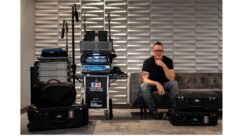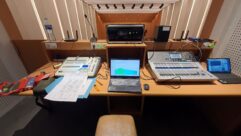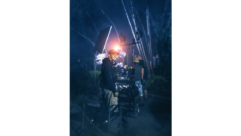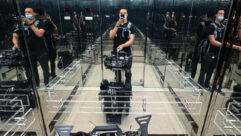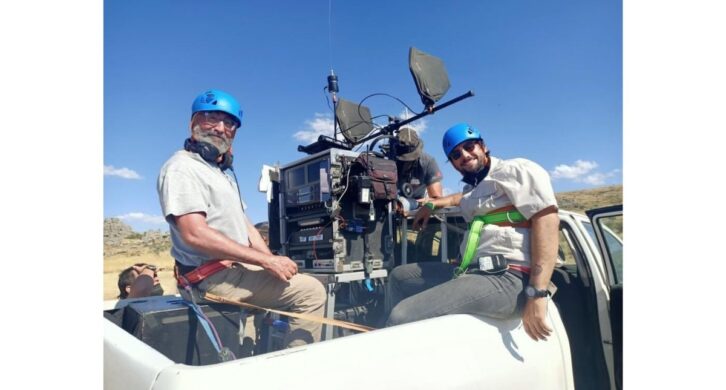
Sound Specialist Glen Marullo with Sound Assistant Gerardo (Gee) Truyol.
Bristol, UK (March 22, 2023) — The American Western has been among the most popular genres in movies and TV for as long as there have been movies and TV. The pantheon of stars is long: John Wayne; Tom Mix; Roy Rogers; Emily Blunt … wait, Emily Blunt? Yes, her new, gritty, no-holds-barred-realistic series, Hugo Blunt’s The English, a BBC / Amazon Prime production, stars Blunt as an Englishwoman who comes to the West in 1890 to avenge her son’s death. Emmy-award winning sound recordist Glen Marullo captured the dialog of the remarkably cinematic series, which was shot almost entirely on location, with central Spain geographically standing in for the Wild West. His sound kit comprises several Lectrosonics wireless systems —, SMV and SMWB belt-pack and HMa plug-on transmitters, Venue2 receivers and ALP690 active directional antennas — which Marullo credits with helping him provide crystal-clear sound.
An alumnus of Southern Illinois University (SIU) Carbondale, Marullo got his degree in cinema and photography. The school also had a great sound program, where he learned the ins and outs of using various Nagra III and NAGRA 4.2 recorders. After graduating he left for New York to seek employment. Around 1979 or 1980, his brother, who was working for Jacques Cousteau, called to teel him they needed a sound op who could run a Nagra for a shoot in Tampa, Florida. They had the recorder and a shotgun mic, and all he’d have to do was be there to do the work. So he drove to Tampa, slung a recorder over his shoulder, and rolled the sound for the Cousteau documentary. While there, Marullo worked on a couple more documentary shoots before he returned to New York in 1983 to join IATSE Local 52. And he kept getting calls for sound work. His documentary work then got noticed by National Geographic, which hired him on for boom work on documentaries and verité documentaries. Union calls provided varied work in New York, on TV shows, commercials, documentaries, and other productions. Over the years, Marullo tried various wireless systems, but once he tried Lectrosonics, he says, there was no going back even 30 years on.
Shooting The English on location about 40 miles outside Madrid in Castilla-La Mancha presented a pristine RF environment. The shoot lasted about six months, and it was during the Covid lockdown, so there weren’t even jets flying in the sky. Marullo explained that he used two boom mics — Schoeps CMIT 5U shotguns for the exteriors and mini CMIPS for the interiors, each into a Lectrosonics HMa transmitter — and everyone in the cast got a wireless mic, usually a DPA Core 6060 lav into either an SMV or SMWB transmitter. In bad weather the HMas had the rubber covers which keep the transmitters well protected.
The period costumes made it easy to hide the transmitters within the actors’ wardrobe. Still, it was a rough, rugged shoot. For one scene he strapped the sound cart with two Venue2 receivers into the back of a pickup truck and parked up on a hillside. The action was in a valley below, with a caravan of wagons which was to stop at some undetermined point where the actors would do some lines of dialog, and then the wagons would resume. One of his assistants aimed a pair of sharkfin antennas at the wagons as they progressed. Still, the actors, wagons, and horses looked like miniatures at that distance; Marullo estimates that they were at least a quarter mile away, and he was almost certain that he would lose them.
And yet, when those lines of dialog came in over the Lectrosonics systems, “it was like they were standing five feet from me.” Even the TV monitors were breaking up because of the long RF links. But the audio was clear as a bell. “The Lectro systems are just rugged … no noise, no hissing, and good, solid sound,” he says. He praises even the ALP690 antennas for their versatility, as they can be run active (powered by the Venue2 receivers) or passive.
Marullo likens director Hugo Blick’s approach in The English to shooting a movie rather than shooting TV, with a goal of getting visually and aurally cinematic results instead of rushing the production. Still, there were several physical challenges the cast, crew, and equipment had to endure, including temperatures occasionally well above 100° F and a particular scene, shot with the star pinned on the ground under a fake dead horse, that ended up requiring a wrangler to pick up and collect the many scorpions that happened to be crawling around.
While The English is streaming currently, Marullo’s more recent projects include Get Millie Black, an HBO production, and then a Paramount+ murder mystery series called The Killing Kind, shot in Bristol, England, where he currently lives.
For more information on Glenn, visit http://www.glenmarullo.com/.
About Lectrosonics
Well respected within the film, broadcast, and theatre technical communities since 1971, Lectrosonics wireless microphone systems and audio processing products are used daily in mission-critical applications by audio engineers familiar with the company’s dedication to quality, customer service, and innovation. Lectrosonics received an Academy Scientific and Technical Award for its Digital Hybrid Wireless® technology and is a US manufacturer based in Rio Rancho, New Mexico. Visit the company online at www.lectrosonics.com. For spare parts and a full line of accessories, visit the company’s online store: Lectrosonics U.S. Online Accessory Store.


